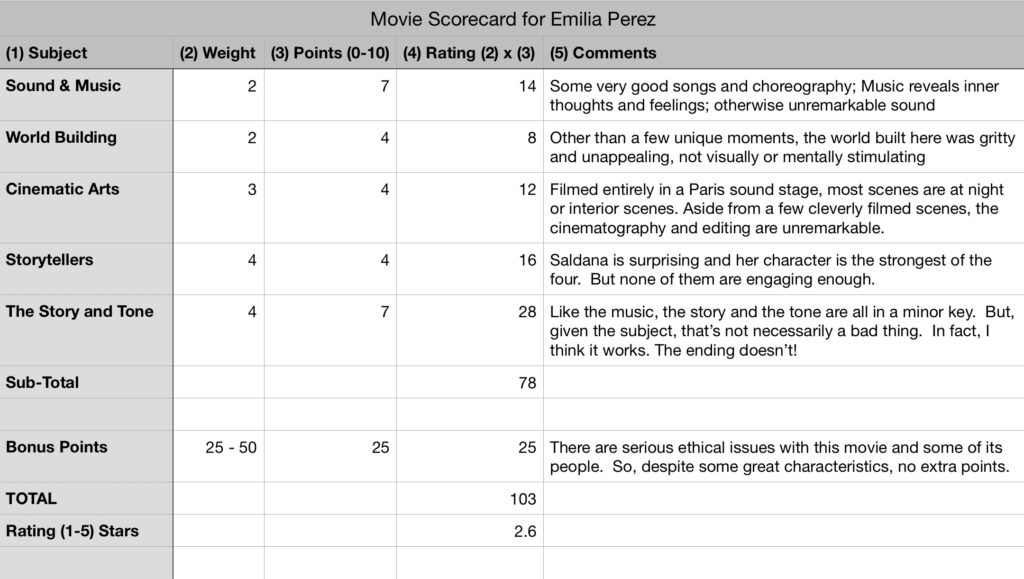Emilia Perez – Scorecard

Emilia Perez – Michael’s Moments
Possibly the most controversial film of the year, Emilia Perez has been blessed with incredibly high levels of recognition and then plagued with controversy that killed its potential victories. To add to the confusion, this movie is the worst-rated movie by the viewing public I have ever seen in an Oscar-nominated movie; so low, in fact, that it falls at the bottom of this year’s, or any year’s, audience rating numbers.
The question to ask is why? What is it about this film that first generated such high numbers of Oscar nominations, and then on to such disrepute? In the sections below, I try to identify some of the characteristics that possibly prompted Oscar nominations. They include very good and dissonantly appropriate music, singing, and choreography integrated tentatively into the story; a couple of nicely filmed and edited sequences, a strong performance from Saldana, and a story that is unique enough and off-kilter enough to benefit from a dissonant setting and tone from what you might expect. Those things score points.
But what brings this movie down is one of my pet peeves about some movies, and that’s the ethical dimensions – this movie insults its audience, and the viewing public seems to agree. Director Jacques Audiard, a Frenchman, has the gall to set the movie in Mexico but film every scene (except a few establishing shots) in a sound stage in Paris. And while he might be credited with scripting the movie mostly in Spanish, which would be appropriate given its setting, he doesn’t understand the language nor the fact that Spanish isn’t the same everywhere in the world – Mexican Spanish isn’t the same as Castilian Spanish. And then he hires actresses to play the key roles, like Gascon (from Spain), Saldana (Dominican Republic), and Gomez (Tex-Mex), who don’t even speak Mexican Spanish.
And let’s talk about loss. Since 2006, when the Mexican president declared war on the cartels, there have been more than 460,000 homicides. Many of those people have simply disappeared with no recourse or reprieve for their grieving families. And yet, Audiard wants to treat the situation with music and dance – how insulting can that feel if you are one of those families? And then there is the totally unnecessary and disgusting scene at the end where Emilia Perez, a former drug lord responsible for hundreds of “disappearances,” is immortalized as a saint – how does that show respect for Mexican losses and religious culture?
You might notice I haven’t even mentioned the issues involved in Gascon’s social media posts regarding Muslims and George Floyd. Yes, they probably ruined Gascon’s chances at an Oscar, but Audiard set the environment up for her failure by not understanding and respecting other cultures. So, in my opinion, it is less her problem than it is the director’s.
Filmmakers do not live in their own isolated world – they want to play in ours. Therefore, they have an ethical obligation to respect and understand where all people live.
Emilia Perez – Story and Tone:
Jacques Audiard attempts to tell a story set in a country he doesn’t know, in a language he doesn’t understand. And to complicate matters, he mashes together threads involving violent Mexican drug lords, transsexuality, and the general idea that you never really do leave your past behind. And if that isn’t enough, he decides to tell the story as a musical with music composed and largely sung by French songwriters. So you have to give him credit for being audacious, but does it work?
The script, written by Audiard in collaboration with two other people, is based on a chapter out of a book by Boris Razón. (Not only am I not familiar with the source material, but I also know nothing about this director nor have I seen anything else he has done. He is French, and this is his first outing to the Oscars.) In that chapter, apparently, Razón tells the unlikely story of a macho Mexican cartel leader who decides to change his entire life by becoming the woman he feels he really is.
Obviously, the storyline generates difficult questions all by itself, especially in a religious country like Mexico. But then, the decision to tell it as a musical is another lurch into a different world. Possibly, that was Audiard’s intent. By taking a theme that is already about difficult transformations and, itself, transforming it into a musical format, he is reinforcing the obvious disconnects and establishing an off-kilter tone.
I’ve been struggling, though, to understand why he decided to do the film in Spanish (with a little bit of English) – two languages he does not speak, and it isn’t clear that he even understands spoken Spanish. You could easily say that it has to be in Spanish because it is about a Mexican drug cartel leader. But France has drug kingpins, and some degree of violence – he could have set it in France, maybe along the French Riviera. Had he done so, it would not have been subject to so much flack from Mexican viewers and critics.
What I’m guessing, but have no evidence to back me up, is that by going to an entirely different language from his own, he is trying to create an environment similar to the disconnect in the story – someone struggling with their own sexual identity – an identity that is at the core of most people. By delivering the film in Spanish, even with French music, he is forcing the cast and crew and himself to think about how difficult it is to live in an alien identity. No, it doesn’t complete the picture and it isn’t perfect, but it is about or as close as he could imagine he could get to set the right tone for the film. I have no idea if that was his thinking, but I think it is the effect. And for that, the movie, if not him, gets some credit. (Is that a “bingo”?)
I also need to add a brief note about the movie’s ending. Simply put, it seems to me to be a cop-out, merely a convenient way to tie up all the pieces, and a lack of imagination on the part of the director and screenwriters.
Related Movies: CODA (Thomas Bidegain, a collaborator on the script)
Emilia Perez – Storytellers
Manitas/Emilia Perez (Karla Sofia Gascon) – Manitas is a greasy-haired, unattractive caricature of a violent Mexican cartel leader who, despite having a wife and two boys, feels trapped in a man’s body and makes arrangements to transform into a woman, Emilia Perez. He makes the transition, with Rita’s help, but then makes some decisions suggesting she can’t quite sever from her previous life. Needless to say, complications arise, creating problems for all involved. Gascon, being a trans woman herself, is obviously very aware of what is involved in changing your sex from male to female and conveys that in this performance. And she has acted before, including in telenovelas. However, she is Spanish, not Mexican, and although I can’t tell, her Spanish is much more Castilian than Mexican, an important disqualification in Mexico. I found her performance intriguing and confident in her understanding of trans sexuality, but her relationships, in the movie, seemed to lack emotional engagement.
Rita (Zoe Saldana) – Rita is the lawyer who, in her late 30s, is trapped in a job doing underappreciated work and has no time for a desired family. Manitas abducts her one day and convinces her, with a large sum of money, to make all the arrangements to make the transition and to protect his family. When Emilia wants to change her situation again, she re-enters Rita’s life, which is inevitably altered. Despite only being nominated for Supporting Actress, Saldana’s role actually has more screen time than Emilia’s does, and the film gives us more insight into Rita than Emilia. In Emilia Perez, she shows she can sing and dance. Her song at the fundraiser, wearing a bright red pantsuit, is a highlight of the movie and shows off some startling dance moves. Rita is much more connecting than Emilia, and Saldana certainly earns an Oscar breaking out of her less demanding sci-fi characters. It should be noted that although Saldana lived in Mexico for a few years, she was raised in a Dominican Republic family, so her Spanish is not Mexican either.
Jessi (Selena Gomez) – Jessi is Manita’s wife and mother of his two boys. She does not recognize Emilia as her former husband and is led to believe that Emilia is Manita’s long-lost, and very rich, relative. After a turn, she falls in love with another man and, well, that’s where things start to get difficult. Gomez, of course, is a known singer, and although she only has a couple of songs, she delivers them well. However, even though Gomez grew up in a Mexican family, it was in Texas, and we all know that Tex-Mex isn’t the same thing as real Mexican. Reportedly, Gomez had to relearn Spanish for this role and still had some problems speaking the language correctly. There are reasons she didn’t receive a nomination, although she is one of the three key women in the movie.
Epifania (Adriana Paz) – Epifania is Emilia’s love interest and would have been a key person in generating some emotional connection with Emilia, but, in fact, the scenes are brief and rather uninspiring. Paz is the only key actor who is actually from Mexico.
There are, of course, a slew of other actors in this movie, some of them doing good jobs. I was impressed with Mark Ivanir, who portrays the Israeli surgeon who does the transsexual operation. He and Saldana have a very interesting song together.
Related Movies: Guardians of the Galaxy (1-3); Avatar (both); some Star Trek movies (Saldana)
Emilia Perez – Cinematic Arts
Many, if not most, of the scenes in Emilia Perez occur either inside or at night. Obviously, this is a decision to accommodate filming the entire movie in a Paris sound stage. Even scenes during the day, usually interior shots, seemed contained and somewhat cramped. However, in one effectively done scene, the three main characters are on the phone back and forth with each other, and they use a split screen to show them talking in real time. That’s been done before, of course, but here it presented an interesting diversion. There is another scene, evocative of Busby Berkeley, where an overhead camera records a dancing sequence from above. Overall, though, I didn’t see anything particularly interesting or unique about camera and editing techniques.
Emilia Perez – World Building
Reportedly, the filmmaker Jacques Audiard scouted locations in Mexico, where the movie is set, but was unable to find anything that matched his expectations. As a result, aside from some panoramic photography (like Mexico City at night), all filming was done in a sound stage in Paris, France. You can, if you look closely, see what seems to be a concrete floor in every single scene. Settings are stark and decidedly simple. This was not a film where money was invested in set designs or decoration. And that, maybe intentionally, gives the movie a slant away from glitz and glamour and more towards gritty and rough reality.
Costume work was similarly unremarkable, with the only exception being the bright red, softly-textured suit that Rita (Saldana) wears at the fundraising dinner where she sings and dances the Oscar-winning song “El Mal”. Emilia Perez did not receive nominations in costumes or production design, and I’m guessing Audiard and his producers were just fine with that.
It did receive a nomination in makeup, and I think that was probably just for one reason – the makeup applied to Gascon for her portrayal of Manitas in the first 30 minutes of the movie. With a prosthetic nose, stringy, long hair, a scraggly beard, dark metallic teeth, and a pocked and pitted face, Manitas is not a pleasant picture. As a brutal evil drug lord, I suppose he isn’t supposed to be. Other than that, I didn’t find anything Oscar-worthy.
Overall, I found the world-building in this movie to be relatively cheap and undeveloped. You expect more from an Oscar-nominated movie.
Related Movies: Anatomy of a Fall (Production Design)
Emilia Perez – Sound & Music
Emilia Perez is, among other things, a musical. And it received nominations for the Score, and two of its songs, one of which, sung by Zoe Saldana, won the Oscar. The songs are all in Spanish, which, itself, is a lilting melodic language, so the lyrics, even deciphered by subtitles, have a romantic and pleasant sound. It is my understanding that the French singer Camille performs many of the songs, and her voice is often dubbed into the soundtrack. I find that a little disappointing because it destroys authenticity, but I guess a decision was made that Gascon and Saldana didn’t have the best singing voices.
The songs are probably best described as emergent— the actors don’t just break out singing; instead, they are carrying on a conversation and, increasingly, the words become rhythmic and melodic. As the song progresses, we come to understand that the purpose of the song is to extend the conversation in directions it isn’t likely to go by itself. They represent additional insight into what the character really feels and thinks. The performance is frequently accompanied by dancing, some of it startlingly good. Selena Gomez, of course, is a known singer, but her role in this movie is limited, and she doesn’t really get a chance to show her talent.
Both the composer, Clement Ducol, and the sound team were nominated for their work, their first nominations. But, perhaps because they are French, I am not familiar with any of their other work. The music is not exactly standard-fare musical stuff, and that may be another part of why audience reaction is so negative, but it is, at times, fun and, at other times, very revealing. I didn’t find the sound work to be very remarkable, although they apparently, in yet another controversy, used AI to alter Gascon’s voice to deepen it for her performance as the male Manitas.
Emilia Perez – What Others Think

Oscar Buzz – Emilia Perez was this year’s Oscar darling…until it wasn’t. The film received thirteen nominations, the most of any non-English movie ever. However, the scandals generated by its subject matter, the lead actress’s social media posts, and its very poor reception in Mexico led to major disappointments on Oscar night. The movie brought home just two Oscars: Supporting Actress for Zoe Saldana, and an Original Song Oscar for two French songwriters for “El Mal”, a song Saldana sings during the movie. My Oscar Quality Index, based on the number and type of nominations and which is normally a good predictor of Oscar performance, was useless this year because of the political reaction.
For reference here are the nominations for Emilia Perez:
Best Picture
International Feature (France)
Director (Jacques Audiard)
Adapted Screenplay (Audiard/Bidegain/Mysius/Livecchi)
Leading Actress (Karla Sofia Gascon)
Supporting Actress (Zoe Saldana) WINNER
Cinematography (Paul Guilhaume )
Film Editing (Juliette Welfling)
Makeup & Hairstyling (Floch-Carbonel/Janvier/Spadaccini)
Sound (Kerzanet/Devoldere/Dussere/Holtz/Barletta)
Original Score (Clement Ducol/Camille)
Original Song (“Mi Camino”, Clement Ducol/Camille)
Original Song (“El Mal”, Clement Ducol/Camille/Audiard) WINNER
Audience Sentiment – “Awful” doesn’t even begin to describe the viewing public’s reaction to this film. It received the lowest audience opinion of any film I have ever seen nominated for an Oscar. Although one of my audience measures was significantly lower than the other, both of them were at the bottom of all 35 of this year’s movie ratings – by far. Audience reviews included statements like “Don’t let awards fool you, this movie is BAD”, “It’s a caricature”, “Overrated, Pretentious, Implausible Trash” and “Not Worth Your Time”. Originally, I thought there was something screwy with the metrics, but I don’t think so – generally speaking, the viewing public hated this movie!
Critical Reviews – As you might suspect, critical reviews were a bit more positive – professional critics and the Academy generally align closer than the public. But still, the film fell near the bottom of the pile. Some of the more positive comments: Brian Tallerico (RogerEbert) lauded the performances from Gascon and Saldana and noted “Even if Audiard doesn’t quite land all of his themes, watching this deeply entertaining trapeze act swoop through the air is all that matters.” Carlos Aguilar (also RogerEbert) called it “A deliriously rhapsodic concoction, at times preposterous in what the lyrics of its Spanish-language songs aim to convey, and others quite affecting.” Manohla Dargis (New York Times) observed “From the start, the movie hooks you because of its abrupt turns, how it veers into places that, totally, narratively and emotionally, you don’t expect.”
Combined Rating – The extremely negative audience reaction ends up producing the largest difference between audience and critic opinion of any of this year’s movies, even though even the critics placed it near the bottom of their list.
Where to Watch: Stream: Netflix; Rent: (Nowhere)


